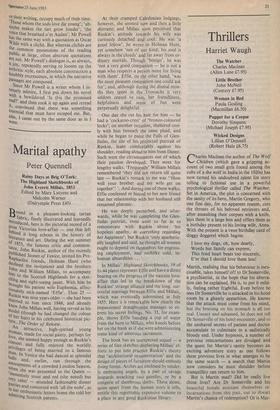Marital apathy
Peter Quennell
Rainy Days at Brig O'Turk: The Highland Sketchbooks of John Everett Millais, 1853 Edited by Mary Lutyens and Malcolm Warner (Dalrymple Press £45)
Bound in a pleasant-looking tartan fabric, finely illustrated and learnedly introduced, here is the pictorial record of a great Victorian love-affair — one that left behind it long echoes in the history of literature and art. During the wet summer of 1853, the famous critic and commen- tator, John Ruskin, author of the recently Published Stones of Venice, invited his Pre- RaPhaelite friends, Holman Hunt (who declined the invitation) and the brothers Jo. hn and William Millais, to accompany lurn to the Scottish Highlands for a sket- c,nlug and sight-seeing jaunt. With him he u.rought his patient wife Euphemia, affec- tionately nick-named 'Effie'. Then 25 Ruskin was nine years older — she had been Married to him since 1848, and already knew John Millais well, having served as his model (though he had changed the colour of her hair) in his celebrated historical pic- ture, The Order of Release. An attractive, high-spirited young vv, omen made for social gaiety, perhaps for love, she seemed happy enough as Ruskin's consort and fully enjoyed the worldly privileges of being married to a famous ,rnao. In Venice she had danced at splendid balls and, earlier, run through the amusements of a crowded London Season, \'v. nen she was presented to the Queen immensely stout and red (she noted) but very calm' — attended fashionable dinner Parties and consorted with 'all the nob?, as 10 her enthusiastic letters home she told her admiring Scottish parents. At their cramped Caledonian lodgings, however, she seemed now and then a little distraite; and Millais soon perceived that Ruskin's attitude towards his wife was curiously detached and cool. He was 'a good fellow', he wrote to Holman Hunt, yet somehow 'not of our kind; his soul is always in the clouds' and far away from or- dinary mortals. Though 'benign', he was 'not a very good companion — he is not a man who respects a person more_ forliving with them'. Effie, on the other hand, 'was the most pleasant companion one could ask for'; and, although during the dismal mon- ths they spent in the Trossachs it very seldom ceased to rain, her friendliness, helpfulness and sense of fun were perpetually delightful.
One day she cut his hair for him — he had a 'cockatoo-crest' of 'bronze-coloured locks'; on another occasion, sheltered cosi- ly with him beneath the same plaid; and while he began to paint the Falls of Glen- finlas, the site of his projected portrait of Ruskin, leant comfortably against his shoulder, reading aloud to him from Dante. Such were the circumstances out of which their passion developed. They went for lengthy walks. 'Frequently' William Millais remembered 'they did not return till quite late — Ruskin's remark to me was "How well your brother and my wife get on together" '. And during one of these walks, Effie confessed or hinted to her new friend that her relationship with her husband still remained platonic.
He was deeply perturbed, and after- wards, while he was completing the Glen- finlas portrait, even went so far as to remonstrate with Ruskin about 'his hopeless apathy, in everything regarding her happiness'; but Ruskin 'only apathetic- ally laughed and said, he thought all women ought to depend on themselves for engross- ing employment, and suchlike cold, in- human absurdities In Millais' Highland Sketchbooks, 19 of its 44 plates represent Effie and have a direct bearing on the progress of the nascent love- affair that led to the breakdown of the Ruskins' strange alliance and the long, suc- cessful marriage between Effie and Millais, which was eventually solemnised in July 1855. Here it is remarkable how clearly the impassioned draughtsman manages to ex- press his secret feelings. No. 33, for exam- ple, shows Effie handing a cup of water from the burn to Millais, who kneels before her on the bank as if she were administering some kind of amorous sacrament.
The book has an unexpected sequel — a series of fine sketches displaying Millais' ef- forts to put into practice Ruskin's theory that 'architectural ornamentation' and the design of pieces of furniture should embody living forms. Arches are enclosed by tender- ly embracing angels, by a pair of savage leopards attacking two gazelles, or by a congerie of slumbrous sloths. These alone, quite apart from the human story it tells, entitle this regrettably expensive volume to a place in any good Ruskinian library.


















































 Previous page
Previous page